| Demographics of Oslo | |
|---|---|
 Population pyramid of the Oslo county in 2022 | |
| Population | 702,543 (2022) |

The population of Oslo is monitored by Statistics Norway. As of 2022, the population of Oslo sat at 702,543.
| Demographics of Oslo | |
|---|---|
 Population pyramid of the Oslo county in 2022 | |
| Population | 702,543 (2022) |

The population of Oslo is monitored by Statistics Norway. As of 2022, the population of Oslo sat at 702,543.
As of 2022, the population of Oslo sat at 702,543.
| Population Group | Year | |||||||||||
|---|---|---|---|---|---|---|---|---|---|---|---|---|
| 1970 [1] [2] | 1980 [1] [2] | 1990 [1] [2] | 2000 [1] [2] | 2010 [1] [2] | 2020 [1] [2] | |||||||
| Number | % | Number | % | Number | % | Number | % | Number | % | Number | % | |
| | 469,175 | 96.2% | 424,756 | 93.4% | 399,878 | 87.3 | 408,298 | 80.4% | 420,469 | 71.7% | 451,534 | 65.1% |
| Norwegian born in Norway | 458,084 | 94.0% | 409,804 | 90.1% | 379,346 | 82.8% | 377,653 | 74.4% | 374,421 | 63.8% | 389,130 | 56.1% |
| Foreign born to Norwegian born parents | 2,129 | 0.4% | 2,585 | 0.6% | 3,054 | 0.7% | 3,507 | 0.7% | 6,241 | 1.1% | 7,221 | 1.0% |
| Norwegian born with one foreign-born parent | 8,962 | 1.8% | 12,367 | 2.7% | 17,478 | 3.8% | 27,138 | 5.3% | 39,807 | 6.8% | 55,183 | 8.0% |
| Total: Immigrants | 18,188 | 3.8% | 30,116 | 6.6% | 58,486 | 12.8% | 99,169 | 19.5% | 166,391 | 28.4% | 241,960 | 34.9% |
| Immigrants | 15,981 | 3.3% | 25,278 | 5.6% | 47,063 | 10.3% | 73,777 | 14.5% | 122,379 | 20.9% | 177,455 | 25.6% |
| Norwegian born to immigrant parents | 492 | 0.1% | 2,395 | 0.5% | 8,164 | 1.8% | 20,963 | 4.1% | 38,110 | 6.5% | 56,899 | 8.2% |
| Foreign born with one Norwegian parent | 1,715 | 0.4% | 2,443 | 0.5% | 3,259 | 0.7% | 4,429 | 0.9% | 5,902 | 1.0% | 7,606 | 1.1% |
| Total | 487,363 | 100% | 454,872 | 100% | 458,364 | 100% | 507,467 | 100% | 586,860 | 100% | 693,494 | 100% |
Immigrants and Norwegian-born to immigrant parents, by country background for Oslo, 2023 [3]
| Persons | |
|---|---|
| 2023 [3] | |
| 0301 Oslo municipality | |
| Immigrants and Norwegian-born to immigrant parents | |
| Total | 243 932 |
| Nordic countries except Norway, EU/EFTA, UK, USA, Canada, Australia, New Zealand | 72 492 |
| Europe except EU/EFTA/UK, Africa, Asia, America except USA and Canada, Oceania except Australia and New Zealand, polar regions | 171 440 |
| Immigrants | |
| Total | 184 251 |
| Nordic countries except Norway, EU/EFTA, UK, USA, Canada, Australia, New Zealand | 64 932 |
| Europe except EU/EFTA/UK, Africa, Asia, America except USA and Canada, Oceania except Australia and New Zealand, polar regions | 119 319 |
| Norwegian-born to immigrant parents | |
| Total | 59 681 |
| Nordic countries except Norway, EU/EFTA, UK, USA, Canada, Australia, New Zealand | 7 560 |
| Europe except EU/EFTA/UK, Africa, Asia, America except USA and Canada, Oceania except Australia and New Zealand, polar regions | 52 121 |
As of 2022, immigrants of non-Western origin and their children enumerated 164,824, and made up an estimated 24% of Oslo's population. [3]
Immigrants of Western origin and their children enumerated 71,858, and made up an estimated 10% of the city's population. Immigrants made up a total of 35% of Oslo's population in 2022. [3] [4]
|
| |||||||||||||||||||||||||||||||||||||||||||||
| Source: Statistics Norway [5] | ||||||||||||||||||||||||||||||||||||||||||||||
The current number of immigrants by country living in Oslo, Norway, as of 1 January 2020 are as follows; [6]
| Nationality | Population (2021) |
|---|---|
| 22,629 | |
| 16,838 | |
| 16,160 | |
| 11,694 | |
| 8,307 | |
| 7,188 | |
| 7,033 | |
| 6,686 | |
| 6,685 | |
| 6,585 |
Religiously, the residents of Oslo are in a majority-minority state with the largest group religious group being adherents to the Lutheran Church of Norway, but these do not make up the majority of residents. Irreligious people make up 28.9% of the population with the largest other religious group being Islam which makes up 9.5% of the city.

Oslo is the capital and most populous city of Norway. It constitutes both a county and a municipality. The municipality of Oslo had a population of 709,037 in 2022, while the city's greater urban area had a population of 1,064,235 in 2022, and the metropolitan area had an estimated population of 1,546,706 in 2021.

Demographic features of the population of Norway, including Jan Mayen, and Svalbard, where the hospital is not equipped for births, include population density, ethnicity, education level, health of the populace, economic status, religious affiliations and other aspects.

Rømskog was a municipality in Østfold county, Norway. The administrative centre of the municipality was the village of Rømskog. The former municipality of Rømskog was separated from Rødenes on 1 January 1902.
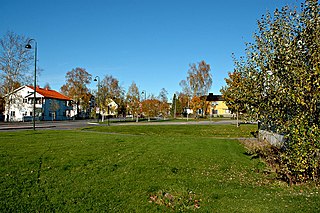
Spydeberg was a municipality in former Østfold county, Norway, until December 31. 2019. At January 1. 2020 it became a part of the new and greater municipality named Indre Østfold Kommune after the region, together with Askim and Trøgstad and Eidsberg and Hobøl kommuner (municipalities).

Eidsberg was a municipality in Østfold county, Norway. The administrative centre of the municipality was the town of Mysen. In 2020, Eidsberg was absorbed into the Indre Østfold municipality.

Våler is a municipality in Østfold county, Norway. The administrative centre of the municipality is Kirkebygden. The parish of Vaaler was established as a municipality on 1 January 1838.

Hobøl was a municipality in Østfold county, Norway. The administrative centre of the municipality was the village of Elvestad. Hobøl is situated about 40 kilometres (25 mi) southeast of Oslo. The parish of Haabøl was established as a municipality on 1 January 1838.

Aurskog-Høland is a municipality in Akershus county, Norway. It is part of the Romerike traditional region. The administrative centre of the municipality is the village of Bjørkelangen. The municipality of Rømskog, in Østfold county was merged into Aurskog-Høland on 1 January 2020.

Nittedal is a municipality and city in Akershus county, Norway. It is part of the traditional region of Romerike. The administrative centre of the municipality is the village of Rotnes.
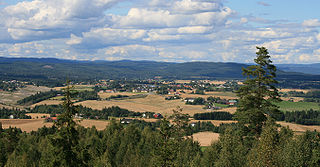
Gjerdrum is a municipality in Akershus county, Norway. It is part of the traditional region of Romerike.

Ullensaker is a municipality in Akershus county, Norway. It is part of the traditional region of Romerike. The administrative centre of the municipality is the city of Jessheim. It has a population of 40,459 inhabitants. Norway's largest international airport Oslo Airport, Gardermoen, is located in Ullensaker.

Hurdal is a municipality in Akershus county, Norway. It is part of the traditional region of Romerike. The administrative centre of the municipality is the village of Hurdal.
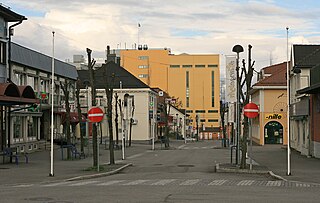
is a municipality in Innlandet county, Norway. It is located in the traditional district of Hedemarken. The administrative centre of the municipality is the village of Stangebyen. Other villages include Bekkelaget, Espa, Bottenfjellet, Ilseng, Ottestad, Sandvika, Sinnerud, Starhellinga, Tangen, and Romedal.
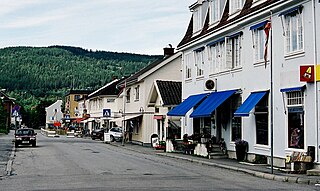
Jevnaker is a municipality in Akershus county, Norway. The administrative centre of the municipality is the village of Jevnaker with a population of 4,302.
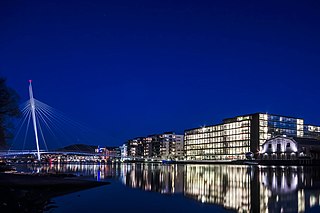
Drammen is a city and municipality in Buskerud county, Norway. The port and river city of Drammen is centrally located in the south-eastern and most populated part of Norway. Drammen municipality also includes smaller towns and villages such as Konnerud, Svelvik, Mjøndalen and Skoger.
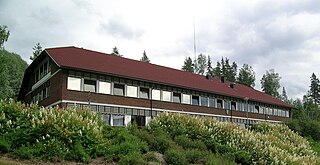
Flesberg is a municipality in Buskerud county, Norway. It is part of the traditional region of Numedal. The administrative centre of the municipality is the village of Lampeland.
In 2017, Norway's immigrant population consisted of 883,751 people, making up 16.8% of the country's total population. Of this number, 724,987 are foreign-born, while 158,764 are Norwegian-born with foreign-born parents. The ten most common countries of origin of immigrants residing in Norway are Poland (97,197), Lithuania (37,638), Sweden (36,315), Somalia (28,696), Germany (24,601), Iraq (22,493), Syria (20,823), Philippines (20,537), Pakistan (19,973) and Eritrea (19,957). The immigrant population comprises people from a total of 221 countries and autonomous regions, but 25% of the immigrants are from one of four migrant groups: Polish, Lithuanians, Swedes and Somalis.
Syrians in Norway are citizens and residents of Norway who are of Syrian descent. Most have arrived as asylum immigrants because of the Syrian civil war.
Somalis in Norway are citizens and residents of Norway who are of Somali descent. They are the biggest African migration group in Norway. 36.5% of Somalis in Norway live in the capital Oslo. Almost all Somali in Norway have come to Norway as refugees from the Somali Civil War. In 2016, Somalis were the largest non-European migrant group in Norway.
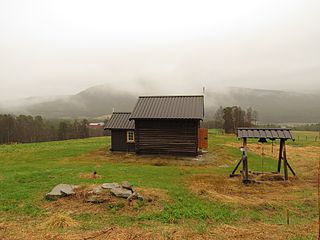
Russians in Norway are people born in Russia or whose parents were both born in Russia and who live in Norway.